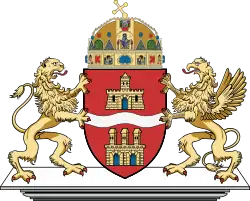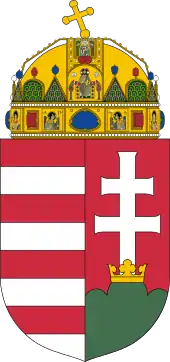Inner City Parish Church in Pest
Budapest's Inner City Parish Church (Budapest-Belvárosi Nagyboldogasszony) (Church of the Blessed Virgin Mary) is the main parish church of Budapest (often referred to as the Parish Church of the City). It is located adjacent to the walls of the Contra-Aquincum Fortress and the Elisabeth Bridge. Its earliest features date back to the Romanesque period. In 1046 Bishop St. Gellért was buried there. The 14th century Hungarian King Sigismund, supported the Gothic reconstructed style. During the reign of King Matthias, two new side ships were added. It was used as a mosque in Turkish times and its memory is a miracle (imafülke) in the south-eastern wall of the sanctuary. After a fire in 1723, between 1725 and 1739, it was restored in baroque style, under the direction of the master builder György Pauer János (1692-1752). In 1828, István Kultsár, the great theater organizer of the era of Enlightenment, was placed in the church's vault for eternal rest. In 1839, it was built with stalls selling the buttresses, which were dismantled in 1932. Then they found the Gothic windows and the twin bed.
| Church of the Blessed Virgin Mary (Budapest-Belvárosi Nagyboldogasszony), commonly known as the Inner City Parish Church | |
|---|---|
 | |
| Religion | |
| Affiliation | Roman Catholic |
| District | Esztergom-Budapest |
| Rite | Latin |
| Ecclesiastical or organizational status | parish church |
| Year consecrated | unknown |
| Status | active |
| Location | |
| Location | Budapest, Hungary |
| Geographic coordinates | 47°29′32″N 19°03′08″E |
| Architecture | |
| Architect(s) | Pauer János György (1692–1752) |
| Type | Neogothic |
| Style | Neoclassical |
| Specifications | |
| Direction of façade | West |
| Length | 118 m (387 ft 1.7 in) |
| Width | 49 m (160 ft 9.1 in) |
| Height (max) | 100 m (328 ft 1.0 in) |
| Website | |
| Website of the church | |
The church was restored several times: János Hild between 1805 and 1808, Imre Steindl in 1889, and Lászlo Gerő after 1945. The painting of the church interior was renovated in 1976–77. In 2010, in the parlor of the sanctuary behind the sanctuary, an Anjou-era throne of Virgin Mary was found, surprisingly intact. The exterior of the church was neglected until the facade was renovated in 2011 after the renovation of the park before it, according to Hungarian architect Mezős Tamás.
During the archaeological excavations carried out between 2014 and 2016, the camp commander's room was accessed and a sub-church was built. After the renovation, on August 15, 2016, the church was handed over to the faithful and visitors by Dr. Péter Erdő.
When the Elisabeth Bridge was being rebuilt after destruction during World War Two, the Communist government of Hungary sought to demolish the church, but through the Church's astute negotiation with Hungary's Communist government, the ecclesial authorities managed to save this historic treasure.


